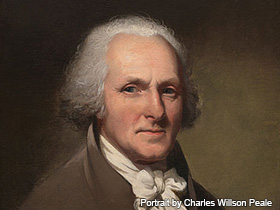American Philosophical Society; Exhumation of a Mastodon; Philadelphia Museum of Natural History and Art; Revolutionary War
Charles Willson Peale was born in 1741, and he is best known for his exquisite portraits of both American and foreign figures associated with the American Revolution. Prior to his painting career, Peale became a noted saddle-maker and watch repairman. Peale served for the Philadelphia militia and was also a Whig party member in the Continental Congress. He later went on to do his part for the scientific community by establishing the Philadelphia Museum of Natural History and Art, all the while continuing his painting with the remainder of his time. Several of Peale's children later went on to become established artists in their own right. Charles Wilson Peale died in 1827.
Charles Willson Peale was born on April 15, 1741, to Charles and Margaret Peale in Queen Annes, Maryland. After being caught embezzling funds from the General Post Office in London, England, Charles Peale, Charles Willson Peale's father, was spared the death sentence and instead charged to live indefinitely in the colonies of North America. According to Charles Coleman Sellers's biography, in describing the prosecutors' reaction to Charles Peale: "...great wonder was expressed among them at the young man's audacity, the artfulness of his devices, and the close resemblance of his forgeries to the genuine hands." Artistic talent can be seen in the lineage of Charles Willson Peale, even though in his father's case, it was used for illegal personal endeavors. However, Charles Willson Peale did not pursue art until his mid-twenties. At age thirteen, Peale was apprenticed to a saddle-maker, which he practiced along with metalwork, watch repair, upholstering, in addition to many other trades. In 1762, Peale opened up his own saddle shop, where he practiced his various practical trades for several years.
During that time of his life, Peale discovered that he had a talent for painting, especially portraits. Peale studied under John Hesselius and John Singleton Copley for some time before a number of generous Maryland plantation owners, upon realizing the amazing talent of the young man, contributed funds to send the young painter to London for formal training. In 1767, Peale made the trip to London and studied with Benjamin West, a renowned painter of the time, for two years. In 1769, Peale returned to Maryland and put his training into practice. As his reputation flourished and his interest in the Sons of Liberty and Revolutionary politics rose, Peale and his family moved down to Philadelphia, Pennsylvania, only to find himself and his family at the center of the Revolutionary crisis.
Peale became an active Whig party member in the political arena and a soldier for the Philadelphia militia, where he fought at Trenton and at the Battle of Princeton. His brother, James Peale, who would also later become a renowned painter, fought at several battles for the Continental Army. During the battles, Peale painted sketches of Continental soldiers from which he would later create enlarged versions. In 1772, George Washington, who at the time was the colonel of the First Virginia Regiment, posed for the first time ever in a portrait, which Peale painted. Peale's enthusiasm and devotion to the revolution kept him in Philadelphia through 1776, where he painted portraits of several more notable American figures as well as others from oversees, including Benjamin Franklin, Thomas Jefferson, John Hancock, and Nathanael Greene.
Even though painting had been one of Peale's passions, he was also a man of many hobbies, loving to keep busy and take on new endeavors. He actively pursued such realms as natural history, and he went on to establish the Philadelphia Museum of Natural History and Art in the mid-1780s, which soon became one of the most prominent and successful institutions of its kind. By 1794, with the museum taking up most of his time, Peale did less and less professional painting, with the exception of those of close friends and family members.
In 1801, in cooperation with the American Philosophical Society and with the help of his companion, President Thomas Jefferson, Peale organized an expedition to unearth the remains of a mastodon in upstate New York. This expedition turned out to be a valuable addition to the rapidly growing scientific movement in America, as well as in the public domain, as Peale reconstructed the skeleton for display in his museum. After the expedition, Peale painted his famous Exhumation of a Mastodon. Peale further varied his vocations by devoting himself to mechanics and invention. Many of his patents include an innovative bridge design, fireplace improvements, a portable vapor bath, and a letter copying machine called a polygraph. For the duration of his term in office, Thomas Jefferson used Peale's polygraph to produce copies of his letters.
Charles Willson Peale devoted much of his time at the end of his life to his family and taught his children to paint, three of whom, Rembrandt, Raphaelle, and Titian Ramsay, went on to become notable artists for themselves. Charles Willson Peale died on February 22, 1827 in Philadelphia, Pennsylvania.
Paintings:
- George Washington at Princeton, The Metropolitan Museum of Art, New York, New York, 1779.
- Benjamin Franklin, Historical Society of Pennsylvania, Philadelphia, Pennsylvania, 1789.
- Exhumation of a Mastodon, Maryland Historical Society Museum and Library, Baltimore, Maryland, 1801.
- Bellion, Wendy. "Illusion and Allusion: Charles Willson Peale's Staircase Group at the Columbianum Exhibition." American Art 2.2 (2003): 18-39.
- Miller, Lillian B. "Peale, Charles Wilson." American National Biography Online. Feb. 2000. Access date: 20 Sept. 2011 <http://www.anb.org/articles/17/17-00654.html
- Sellers, Charles Coleman. Charles Willson Peale. New York: Charles Scribner's Sons, 1969.
- Semonin, Paul. "Peale's Mastodon: The Skeleton in our Closet." Common Place 4.2 (2004). 1 Oct. 2007 <>http://www.common-place.org/vol-04/no-02/semonin/>.
- The Charles Willson Peale Family Papers. 1999. The Smithsonian Institution — National Portrait Gallery. 1 Oct. 2007. <>http://www.npg.si.edu/exh/peale/index.htm>.
Painter Charles Willson Peale founded the Philadelphia Museum of Natural History and Art.

